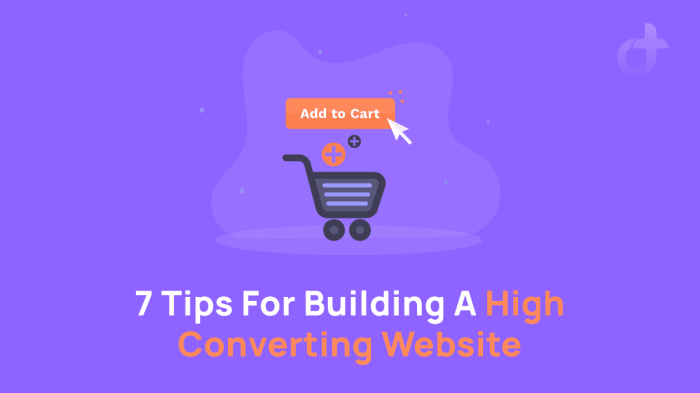Building a High-Converting Website sets the stage for skyrocketing your online game. With killer design elements and compelling content, get ready to crush those conversion goals like a boss.
Get ready to dive into the world of high-converting websites and watch your business soar to new heights.
Importance of a High-Converting Website
In today’s digital age, having a high-converting website is essential for businesses looking to thrive in the competitive online market. A website that effectively converts visitors into customers can significantly impact the success and growth of a business.
Key Benefits of a High-Converting Website
- Increased Sales: A high-converting website can lead to a higher conversion rate, resulting in more sales and revenue for the business.
- Improved Customer Engagement: By providing a seamless user experience and valuable content, a high-converting website can enhance customer engagement and loyalty.
- Builds Trust and Credibility: A website that converts well instills trust in potential customers, showcasing professionalism and reliability.
- Enhanced Brand Visibility: With a high-converting website, businesses can increase their online presence and reach a wider audience, boosting brand visibility.
Impact of a High-Converting Website on Sales and Customer Engagement
A high-converting website plays a crucial role in driving sales and fostering customer engagement. It acts as a powerful marketing tool that can attract new customers, retain existing ones, and ultimately boost the bottom line of the business.
Design Elements for Conversion Optimization
When it comes to building a high-converting website, design elements play a crucial role in capturing the attention of visitors and guiding them towards taking desired actions. From color schemes to fonts and visuals, every element contributes to the overall success of a website in terms of conversion rates.
Color Schemes
Color schemes have a significant impact on the overall look and feel of a website. The use of colors can evoke specific emotions and feelings in visitors, influencing their behavior and decision-making process. It is essential to choose colors that align with your brand identity and resonate with your target audience to create a cohesive and visually appealing website.
Fonts
Fonts are not just about aesthetics; they also play a crucial role in readability and user experience. The right font choice can enhance the overall design of a website and make the content more engaging for visitors. It is important to select fonts that are easy to read and align with the tone of your brand to ensure a positive user experience.
Visuals
Visual elements such as images, videos, and infographics can help convey information more effectively and capture the attention of visitors. High-quality visuals can enhance the overall look of a website and make it more engaging for users. It is essential to use visuals strategically to support your content and guide visitors towards conversion points on the website.
Intuitive Navigation
Intuitive navigation is crucial for improving user experience and guiding visitors towards desired actions on the website. A clear and well-structured navigation menu can help users easily find the information they are looking for and navigate through the website seamlessly. By simplifying the navigation process, you can increase the likelihood of visitors converting into customers.
Responsive Design
With the increasing use of mobile devices, having a responsive design is essential for optimizing conversions on a website. A responsive design ensures that the website adapts to different screen sizes and devices, providing a seamless user experience across all platforms. By making your website accessible and user-friendly on mobile devices, you can reach a wider audience and improve conversion rates.
Creating Compelling Content: Building A High-Converting Website

When it comes to creating compelling content for your website, it’s all about engaging your audience and driving conversions. Your content should be persuasive, informative, and tailored to your target audience to encourage them to take action.
Significance of Clear and Concise Messaging
Clear and concise messaging on a website is crucial for grabbing the attention of your visitors and guiding them towards conversion. By keeping your content straightforward and easy to understand, you can effectively communicate your value proposition and encourage users to take the desired action.
Storytelling for Enhancing Conversion Rates, Building a High-Converting Website
Storytelling is a powerful tool that can be used to enhance conversion rates on your website. By weaving a narrative that connects with your audience on an emotional level, you can create a memorable and engaging experience that resonates with visitors. This storytelling approach can help build trust, establish credibility, and ultimately drive more conversions for your business.
Call-to-Actions (CTAs) Best Practices
When it comes to driving conversions on your website, the Call-to-Actions (CTAs) play a crucial role. An effective CTA can make all the difference in turning visitors into customers. Let’s dive into some best practices to make your CTAs stand out.
Key Elements of an Effective CTA
- Clear and Actionable Text: Use concise and compelling language that tells users exactly what to do.
- Contrasting Colors: Make sure your CTA button stands out from the rest of the page to attract attention.
- Strategic Placement: Put CTAs where visitors are most likely to see them, such as above the fold or at the end of a blog post.
- Mobile Optimization: Ensure that your CTAs are easily clickable and visible on mobile devices.
Placement Strategies for CTAs on a Website
- Above the Fold: Place CTAs where visitors can see them without having to scroll down the page.
- At the End of Content: Include CTAs at the bottom of blog posts or product pages to capture visitors who have read through the content.
- Pop-ups and Slide-ins: Use these more intrusive CTAs sparingly to grab attention without annoying visitors.
Examples of Compelling CTAs
“Start Your Free Trial Today!”
“Get 50% Off Your First Purchase Now!”
“Download Our Ultimate Guide to Boost Your Sales!”
User Experience (UX) Optimization
User Experience (UX) design plays a crucial role in determining website conversion rates. A well-designed website that provides a seamless and intuitive user experience is more likely to convert visitors into customers. By focusing on optimizing UX, businesses can enhance user satisfaction, encourage engagement, and ultimately drive conversions.
Improving Website Usability and User Experience
Improving website usability and user experience is essential for maximizing conversions. Here are some methods to enhance UX design:
- Ensure clear navigation: Make it easy for users to find what they are looking for on your website.
- Optimize mobile responsiveness: With the increasing use of mobile devices, ensure your website is mobile-friendly.
- Streamline the checkout process: Simplify the steps required for users to complete a purchase.
- Use intuitive design elements: Employ easy-to-understand buttons, forms, and calls-to-action.
Optimizing Page Load Speed
Optimizing page load speed is crucial for improving user experience and increasing conversions. Here are some tips to enhance page load speed:
- Optimize images: Compress images to reduce file size without compromising quality.
- Minimize HTTP requests: Reduce the number of elements on a page that require separate server requests.
- Leverage browser caching: Enable browser caching to store website data locally, reducing load time for returning visitors.
- Utilize Content Delivery Networks (CDNs): Distribute website content across multiple servers to decrease load times.
A/B Testing and Data Analysis

A/B testing is a crucial tool in optimizing website conversions. It allows you to compare two versions of a webpage to see which one performs better in terms of user engagement and conversion rates. By analyzing the results of these tests, you can make data-driven decisions to improve your website’s performance.
Setting up and Conducting A/B Tests
- Identify the goal: Clearly define what you want to achieve with the A/B test, whether it’s increasing click-through rates, improving form submissions, or enhancing overall user experience.
- Create variations: Develop the different versions of the webpage that you want to test, making sure to change only one element at a time to accurately measure its impact.
- Randomize traffic: Split your website traffic evenly between the original page and the variations to ensure unbiased results.
- Monitor and analyze: Track key metrics such as bounce rate, time on page, and conversion rates to determine which version performs better.
- Implement changes: Based on the results of the A/B test, implement the changes that lead to improved performance on your website.
Role of Data Analysis in Website Optimization
Data analysis plays a crucial role in identifying areas for improvement on a website by providing insights into user behavior and preferences. By analyzing data collected from A/B tests, heatmaps, and user feedback, you can pinpoint specific elements that are hindering conversions and take targeted actions to address them.
